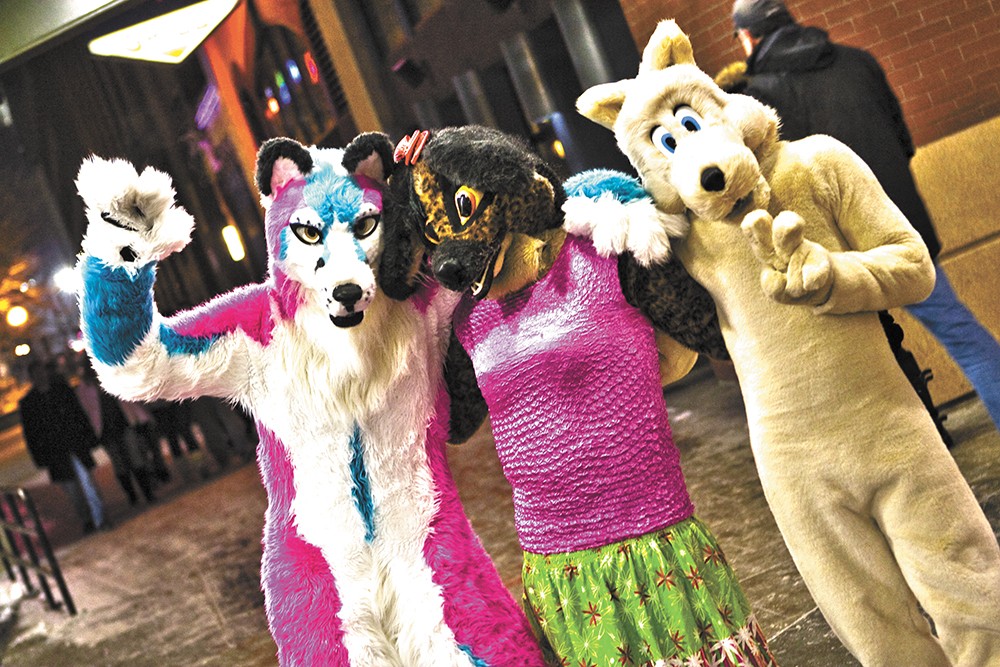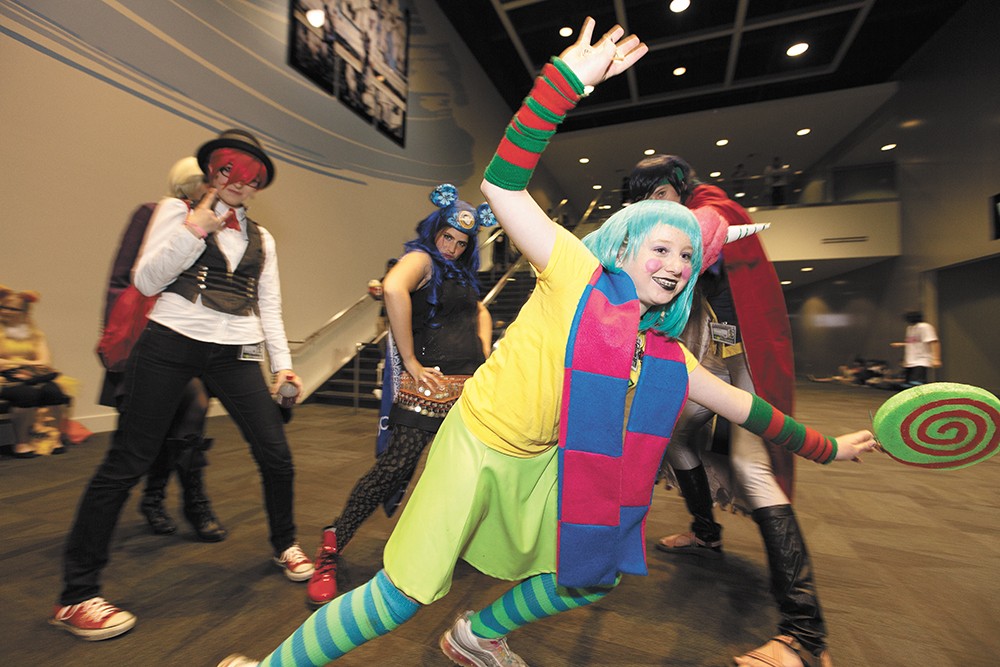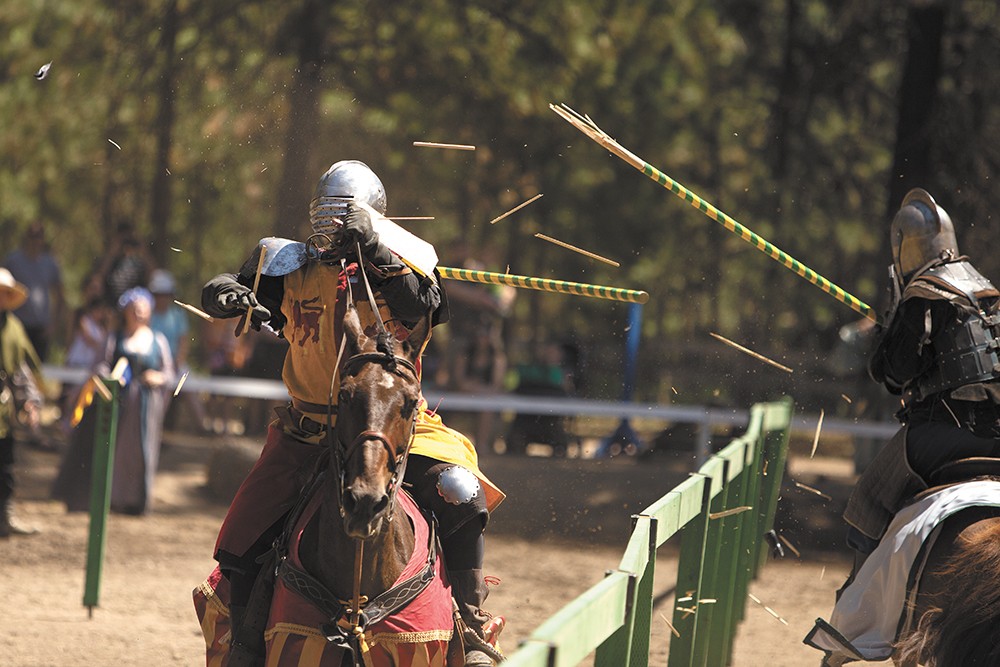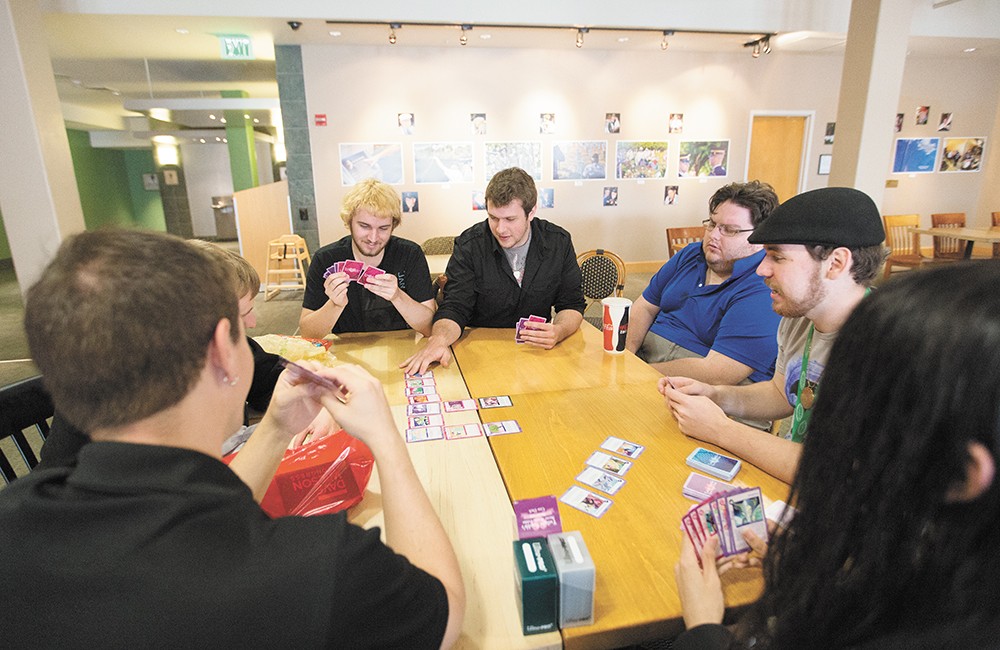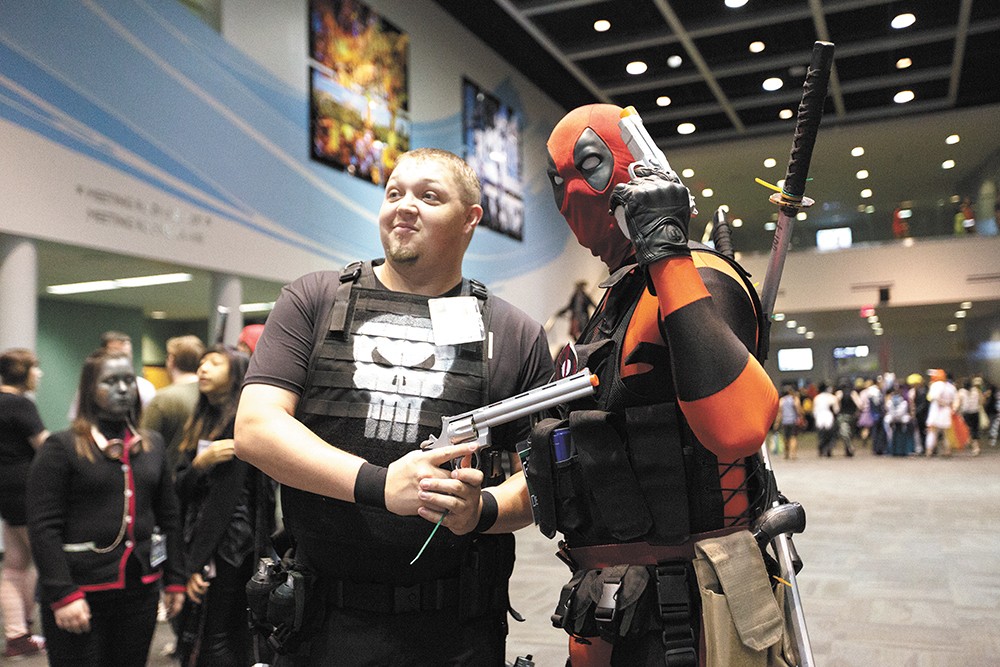It doesn't matter who this man really is. In this world, no one cares that he's a 31-year-old business owner who lives in North Idaho. What matters is who he wants to be.
Who he wants to be is Quip — a mostly white York Chocolate cat with a striped tail.
Quip likes to hide underneath desks and sneak inside cabinets when they're open. Occasionally, he'll nap in the afternoon sun on the top of a late-model sedan parked in the driveway. He likes stuffed animals and jumping on the counter.
Sitting at a downtown Spokane coffeehouse, Quip explains that he's a lot more than just a man sitting here. That this animal side is him, too — a part of his personality he has nurtured for decades as a member of the "furry fandom," a worldwide subculture devoted to animal characters with human traits. For some, being furry means enjoying books, cartoons or films starring talking animals — say, Watership Down or The Muppets. For others, it means adopting an animal personality, or a "fursona," like Quip. And for others, it means spending thousands of dollars to create a custom "fursuit" to wear at conventions and furry meetups.
Quip, who spoke on the condition his real name wasn't printed, is this man's fursona. Being Quip is his escape.
"My fursona — it's like a person's counterpart — is a cat. Others identify themselves as a wolf," he says. "We even have people who identify themselves as dragons, lizards — we call them scalies. There's no fur, but we still love them too."
Escapism is nothing new to the human experience. Ask the guy who drops his paycheck on Zags season tickets, or the people waiting in line for a movie on a Friday night. Ask comic book fans, artists, musicians, gamers, woodworkers, distance runners, Civil War re-enactors, avid fans of Game of Thrones. Odds are they'll all tell you they're just looking for a vacation from the norm, a few minutes when they can forget the bills to pay, the obligations to meet, the 9-to-5, the problems they don't want to address.
"When we fantasize, we experience the same emotions we would feel if we were in reality. Think of the fear you feel with a nightmare. Happy fantasies make us feel good," says Norman Holland, author of Literature and the Brain and a researcher of psychoanalytic psychology. "All work and no fantasy makes Jack pretty gloomy. We all should have some space for fantasy in our lives. Fantasies — escapism — give our emotions a workout. That's why the imaginative arts are good for you."
But even today, when there are arguably more outlets for people to escape their everyday lives than ever before in our history, some fantasy cultures still raise eyebrows. Some people feel they are social pariahs because of how they choose to escape. Some say they have keep their fantasy lives secret.
Like Quip. He says to him, being a furry is just a casual hobby. But he knows that's hard to understand — so his family and friends, and especially his clients, have no idea that he's a part-time cat.
"You know, you're a professional," he says. "What would happen if tomorrow you dressed up like a half-nude panda bear and started playing fetch with all the vases in the office?"
People aren't that open-minded, he says.
"I do much the same thing [as anyone else]," he says. "I just go home, I make myself a nice little salad, I catch up on email, and then I put on a dog collar and go to sleep."
Ethan Gilsdorf, author of Fantasy Freaks and Gaming Geeks, has made a career out of studying escapism. He writes about geek culture for the New York Times, Boston Globe and Washington Post and has appeared as an expert on escapist cultures on PBS, the Discovery Channel and BBC. He points to what he sees as one of the modern-day origins of fantasy-escapist culture: Dungeons & Dragons, a game that remains wildly popular today.
"Dungeons & Dragons, which celebrates its 40th anniversary this year, was ... one of the few 'games in town' for immersive fantasy escapism when it first came on the market in 1974," he says. "Back then, a game like D&D was cutting edge. Today, its tools — dice, maps, rules books — seem rather rudimentary compared with the sophisticated toys and diversions we have today."
But as technology has evolved, Gilsdorf says fantasy has become a part of day-to-day life. It's in the CGI movie effects that make movie monsters larger than we could have ever imagined. It's in the immersive digital communities and social media that have become as integral to our lives as going to work and eating breakfast. Fantasy isn't just for geeks anymore.
In fact, fantasy escapism is a booming business. Last year the largest comic and pop culture convention, San Diego Comic-Con International, attracted more than 130,000 attendees. Tournaments of one of the world's most popular video games, Defense of the Ancients — better known as DotA — have become so massive, they're being broadcast on ESPN.
"People are attracted to fantasy lives for a variety of reasons: to escape from bad times, to get a break or respite from day-to-day life, to experience wonder and magic, to feel empowered, to be able to do something or be someone they can't be or do in real life, to feel camaraderie, fellowship and socialization," Gilsdorf says. "Ultimately, we want to feel part of something bigger than ourselves, something grander, something more epic than day-to-day life."
Even the smaller subcultures, like the furry fandom, play to that notion.
This year's Anthrocon in Pittsburgh attracted 5,861 furries from 26 countries. That's a far cry from the beginnings of the furry fandom, which sprouted out of 1970s fanzines, found an online home in 1990s chat rooms and took off with the advent of the World Wide Web.
Here in Spokane, the Inland Northwest Fur Folk group on Meetup.com boasts more than 130 members — that's everyone from actual "fursuiters" who wear animal costumes, to folks like Quip who simply have fursonas but don't dress up, to people who just like to nerd out on talking animal characters.
Ritzgaul Gryphs is another member of the group here. The 28-year-old man works at a Spokane Valley grocery store, but he won't divulge any other details about himself or use his real name — and it's not because he's ashamed. He says it's how the media has portrayed the furry fandom as an a animal-costuming-wearing sex group of sorts that keeps him anonymous. He says that's not what the the majority of the fandom is about.
And yeah, sure, he says some furries do like to have sex while dressed up as foxes and wolves. But not all of them. And it's certainly not exclusive to fursuiters.
"There's no denying things like that go on," he says. "There's no denying that at Trekkie conventions there's going to be Klingon sex."
Ritzgaul says he's been a furry since 1998, but he's never assumed a fursona. He's a human. "I never found a furry side of me," he says, "but when you really deeply think about it, humans are animals too."
But he's just as much a part of the fandom as people who wear costumes. When Ritzgaul thinks about his attraction to the furry fandom, he thinks about being an 8-year-old kid watching afternoon cartoons. His still remembers his first crush: a villainous wolf on the cartoon TaleSpin.
When he found the fandom as a teenager, he said it actually changed him as a person.
"It got me social. It got me out of the house more. It got me to discover myself as a person. It helped me," he says. "It pretty much saved me from boredom. It helped me become more active and discover things, learn things."
Quip, the man who identifies in the fandom as a cat, says with furries he found a group that was more accepting of who he was than anyone else he'd encountered.
"That's the interesting thing about the furry fandom, it's really an anything-goes sort of community," Quip says. "Nobody will lambaste you because you listen to this type of music as opposed to another type of music. No one will rib you because you like to watch cartoons."
So it isn't sexual for these men, but would they prefer to date someone who is a furry, too?
Quip answers that with a laugh. "If you know anyone, just..." — and he holds his hand up to his ear like a telephone.
Every summer, far from the city, far from their homes, they travel back in time. For 20 years, the cast of the Northwest Renaissance Festival have made camp on a plot of dusty land in Nine Mile Falls, evoking a time when men were fighters and ladies were damsels. Each weekend, they live here among their fellow time travelers.
Each weekend, they forget who they really are.
It's a sentiment you hear from several members of the Renaissance Festival cast — being here is a vacation from themselves, from their problems.
Ken Slack, 45, is the fight director at the Festival — essentially, the guy who coaches the other actors how to sword-fight and make it look realistic.
He has been with the festival for 20 years — moved here from Boise, in fact, to be a part of it. Slack, who is on disability and suffers from agoraphobia, says the festival has helped him break through those issues he deals with every day.
"Anytime I have to leave the house, I have to start preparing for it far in advance, and calm my nerves and almost medicate beforehand in order to be able to get out of the house," he says. "That's why [it's] so good for me — it gets me out of the house."
Fantasy role-playing such as this is something that can actually be very therapeutic for disabled communities, Gilsdorf says.
"For the disabled community, a fantasy experience like a role-playing game or video game can offer a safe, non-judgmental space where the disabled or 'differently-abled' have agency and authority, and where people they meet might not know about their mental, emotional or physical handicaps. This can be liberating," he says.
At Renaissance Festival, Slack plays a pirate named Sir Lazloe. "He's a knight, he's an explorer. He does everything I've always wanted to do in real life, but I haven't had the money to do. He's an English noble, friend of the king. At one point he was married to a gypsy," Slack says. "It's kind of like I put on a mask when I become him. ... Once I put the mask on, I'm a totally different person and it doesn't bother me. I don't see the crowd out there."
For one month each year, he lives with this ragtag family of actors. He wears his mask, and he feels good.
But when August comes each year and the festival winds down, he knows it's OK to be Ken Slack again. Being Sir Lazloe has helped him, but he'll never stop being the person he is under the mask.
"The last few women I've dated, I've said, 'Don't fall in love with Sir Lazloe!' Because that's not me 24/7," he says. "Most of them I've broken up with because they have fallen in love with Sir Lazloe, and Ken comes around and it's a different story. I've always been a lone kind of guy."
They said they caused an earthquake. After BronyCon 2013 — the largest annual convention for bronies, male fans of the cartoon My Little Pony: Friendship is Magic — blogs blew up with the news: There were so many people jumping up and down at the late-night concert at the end of the convention, it allegedly caused the building's seismometer to measure 1.6 on the Richter scale.
Whether it's true or not, it would make sense: Bronies do things big. In just a few years, the brony fandom — yes, that's "bro" plus "pony" — has exploded. The first BronyCon, held in 2011, had just 100 attendees.
This year's BronyCon, held in early August in Baltimore, had 9,607 attendees and raised $26,877 for charity.
Dustin Coffey, who acts as the admin for the Spokanterlot Bronies Facebook group, says when you declare yourself a brony, you get asked a lot of questions. But they're ones you have to ask yourself first. "When I first got into it, and a lot of times it's just like, 'We're liking a show about candy-colored cartoon equine. Let's just think about this, guys, for just five seconds,'" he says.
The brony fandom is fairly new, but has spread quickly since the cartoon's debut in 2010. The show originally was intended for a young female audience, but after it became Internet meme fodder on sites like 4chan, it soon gained a 20-something male following — the sort of guys who might have embraced programs like The Powerpuff Girls. Meetup groups popped up in cities and college campuses. The weird phenomenon was captured in the 2012 documentary Bronies: The Extremely Unexpected Adult Fans of My Little Pony.
"It's so totally uncool that I think it comes clear around the other end of the spectrum and makes it cool," Robert Thompson, a Syracuse University professor and media scholar, told the Omaha World-Herald last year. "It's one thing for guys to like motorcycles and muscle cars and soccer. For a guy to like My Little Pony, it's so out there that it becomes almost avant-garde. It has a hip quality to it."
When Coffey, 20 years old and well over 6 feet tall, sits down at a Spokane Valley Starbucks, he's wearing a black T-shirt with a yellow-and-pink pony across the chest that reads "YAY." He shows off the gold medallion he picked up at a pony convention — it's got a pony etched into it. He takes out his phone — with a pony phone case — to show off some of his pony fan art, which he sells at conventions.
"My dad's a total sci-fi nut. He got me watching Star Trek, Firefly, Babylon 5. Like, a bunch of science fiction, and Lord of the Rings and things like that," he says. "I've dabbled in a lot of other nerdy things. Like, really nerdy things."
But he says nothing had ever grabbed him the way My Little Pony did.
"A lot of bronies, in all honesty, are very socially awkward. And I was too, for the longest time," he says. "Like, in high school I was having a really hard time socially interacting with people. And then watching ponies, talking with other bronies, and then working retail helps too. You have to talk to people."
Kevin Parks, a 27-year-old student at Eastern Washington University, says he loved the show instantly — not just because it was funny and well-written, but had a good message.
"One of the big things it's about is just being a good, helpful person," he says. "Not judging people. Not being mean. Always being polite. Trying to look from another person's perspective."
Parks and Coffey say the local group kind of reflects that: It's just bronies hanging out, eating pizza, playing games, going to movies. Though there are some female bronies (some call themselves "pegasisters"), bronydom — at its core — is simply about just being kind and having fun.
Parks says some people don't buy that it's that innocent.
"It's not so much that it's just a cartoon. It's the fact that people look at it and go, 'OK, it is a cartoon for little girls. But what else?'" he says. "They always look at it and go, 'There must be something deeper. There must be something actually wrong with this person, either mentally or socially. They have to be inept.' Because socially, we should not like something like that. Regardless of whether it's just a cartoon. Even cartoons for boys, something like SpongeBob — if a man in his 40s likes SpongeBob, you kind of laugh at the whole idea. But if a man in his 40s likes a little girl's cartoon?"
Coffey, one of five boys in a Mormon family, says his biggest reservation was telling his father that he was not only a fan of My Little Pony, but a superfan. So he got his younger brothers to watch it, too, and soon found out his older brother was also watching the show at college.
"We sat down, watched it, and he gets, like, this angry look on his face," he says of when he and his brothers watched the show with their father. "Then he finds out, 'OK, they're just watching a show about ponies. That is weird, but at least it's not gay or whatever.'"
Parks says when he goes to hang out with the bronies, he's in a safe spot — one free from ridicule and other macho expectations.
For some reason, not everyone can understand a group of guys who would want that.
"Let's put it this way: I would not wear this shirt around my girlfriend," he says, pointing to his T-shirt — which depicts a My Little Pony riff on Van Gogh's Starry Night. "I would not go out wearing this shirt with my girlfriend. She would kick my butt. It's not that she doesn't like it.
"Let's just say that she... how can I put this lightly? She's a little uncomfortable with it."
Chris Martin makes friends out of foam. Today he walks into Merlyn's, the downtown comic shop where he works, with one of them — one he's been spending a ton of time with lately. He proudly carries in a 6-foot tall, foam-and-PVC recreation of the extraterrestrial tree character Groot from the film Guardians of the Galaxy. He's been working on Groot for months, whittling away by day, propping him up in the corner of his bedroom at night.
"My wife's not into it. She sees Groot every night standing in the bedroom, and she's just, like, 'OK,'" he says, smiling.
At this point, she's gotten used to it. Martin — most people know him by his nickname, Burr — has become known locally for his cosplay creations as the host of the Spokane Comicon costume contest.
At any time, Martin, 46, can open his closet and become Indiana Jones, a Ghostbuster, Hawkeye from The Avengers. He can be Captain America, Hitman, Star-Lord, Gru from Despicable Me. "I know what my family is going to wear on Halloween in March," he says.
And of course, at any time, he can be a Stormtrooper, a Sandtrooper and an Imperial Officer from Star Wars. Martin is a card-carrying member of the 501st Legion — an elite organization of hard-core Star Wars costume enthusiasts who have exactly replicated costumes from the Star Wars films. They wear those costumes to brighten the lives of kids in need.
After a rigorous approval process, Martin was accepted into the 501st, and now is deployed to children's hospitals, parades and birthday parties when duty calls. When Weird Al Yankovic played the Spokane County Fair a couple of years ago, he asked for Stormtroopers to dance onstage during one song. Martin was there, too.
One time "we were doing a parade in Coeur d'Alene and it started to snow," he says. At the end of the parade loop, he hopped into the back of a truck to get a ride back to the start. "So I'm standing in the back of this wagon, I have Darth Vader over here, I have Spider-Man standing next to me. And this princess in front of me. It's dark, it's snowing, it's, like, 30 degrees. I'm like, 'Where's my life going right now? How did I get here at this moment?'"
Sure, not every guy his age makes costumes in their spare time. Not every guy his age thinks a badass Iron Man costume would be the Holy Grail of their collection. But he's not every guy.
"This is my car — I don't know anything about fixing cars. But this is my car," he says, relating to guys who tinker with classic cars. "It's like they're on eBay and they see a window that's $500 that they need. It's the same with me. I'm like, 'Oh, I could really use that helmet.'"
He's not ashamed. He gets to make kids smile. He gets to play Halloween whenever he wants. Every now and then, he'll run into someone who'll call him a nerd.
Every now and then, it'll even piss him off.
And then sometimes, he'll have a moment that surprises even him. Like the time at a Children's Hospital party, when a tiny girl undergoing chemotherapy walked so brazenly up to him and Darth Vader and handed them each — without a glimmer of fear in her eyes — a bright pink My Little Pony doll.
It sits on a shelf in his home — a reminder of those moments when the magic is real. ♦
Mark Your Calendar
Get a taste of all things fantasy, sci-fi and escapist at this weekend’s SpoCon convention at the downtown Doubletree Hotel, Aug. 15-17. Visit spocon.org for more details. Later this fall, the new Pac Con Spokane comic convention, Oct. 24-26, boasts an impressive lineup of industry stars, including Stan Lee and William Shatner.

